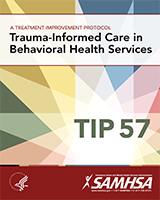Exhibit 1.4-1Grounding Techniques
Grounding techniques are important skills for assessors and all other behavioral health service providers who interact with traumatized clients (e.g., nurses, security, administrators, clinicians). Even if you do not directly conduct therapy, knowledge of grounding can help you defuse an escalating situation or calm a client who is triggered by the assessment process. Grounding strategies help a person who is overwhelmed by memories or strong emotions or is dissociating; they help the person become aware of the here and now. A useful metaphor is the experience of walking out of a movie theater. When the person dissociates or has a flashback, it’s like watching a mental movie; grounding techniques help him or her step out of the movie theater into the daylight and the present environment. The client’s task is not only to hold on to moments from the past, but also to acknowledge that what he or she was experiencing is from the past. Try the following techniques:
Ask the client to state what he or she observes.
Guide the client through this exercise by using statements like, “You seem to feel very scared/angry right now. You’re probably feeling things related to what happened in the past. Now, you’re in a safe situation. Let’s try to stay in the present. Take a slow deep breath, relax your shoulders, put your feet on the floor; let’s talk about what day and time it is, notice what’s on the wall, etc. What else can you do to feel okay in your body right now?”
Help the client decrease the intensity of affect.
“Emotion dial”: A client imagines turning down the volume on his or her emotions.
Clenching fists can move the energy of an emotion into fists, which the client can then release.
Guided imagery can be used to visualize a safe place.
Distraction (see #3 below).
Use strengths-based questions (e.g., “How did you survive?” or “What strengths did you possess to survive the trauma?”).
Distract the client from unbearable emotional states.
Have the client focus on the external environment (e.g., name red objects in the room).
Ask the client to focus on recent and future events (e.g., “to do” list for the day).
Help the client use self-talk to remind himself or herself of current safety.
Use distractions, such as counting, to return the focus to current reality.
Somatosensory techniques (toe-wiggling, touching a chair) can remind clients of current reality.
Ask the client to use breathing techniques.
Ask the client to inhale through the nose and exhale through the mouth.
Have the client place his or her hands on his or her abdomen and then watch the hands go up and down while the belly expands and contracts.
Source: Melnick & Bassuk, 2000.

